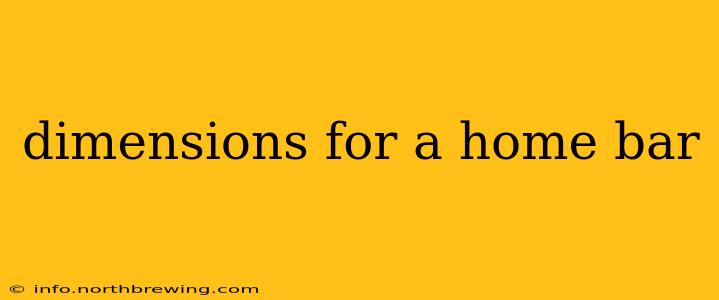Building a home bar is a fantastic way to elevate your entertaining game and create a stylish focal point in your home. But before you start stocking your shelves with premium spirits, you need to consider the dimensions. The perfect size will depend on your space, your entertaining style, and the level of functionality you desire. This guide will help you determine the ideal dimensions for your home bar, covering everything from compact setups to larger, more elaborate designs.
What are the standard dimensions for a home bar?
There's no single "standard" size, as home bars range dramatically in scale. However, we can break down typical dimensions based on common setups:
-
Compact Bar (Small Space): A compact bar might measure 24-36 inches wide, 12-18 inches deep, and 36-42 inches high. This is perfect for apartments or smaller homes where space is at a premium. Think a narrow countertop with shelving above.
-
Standard Bar (Medium Space): A standard bar typically ranges from 48-72 inches wide, 18-24 inches deep, and 36-42 inches high. This allows for more storage and workspace, accommodating a wider range of drinks and accessories.
-
Large Bar (Extensive Space): Larger bars can extend to 72 inches or more in width and depth, often incorporating features like a built-in sink, refrigerator, or even seating. These are ideal for homeowners who frequently host large gatherings.
Remember, these are just guidelines. You can adjust the dimensions to perfectly fit your available space and desired functionality.
What is the ideal height for a home bar?
The ideal bar height is generally considered to be between 40 and 42 inches. This height provides comfortable serving and drinking, mirroring standard bar heights found in pubs and restaurants. However, you can adjust this based on your personal preference and the overall design of your space. Consider the height of your existing counters and furniture to maintain a cohesive aesthetic.
How much space do I need for a home bar?
The space required depends heavily on the scale of your envisioned bar. Consider these factors:
- Storage needs: How much liquor, glassware, mixers, and bar tools do you plan to store? More storage requires more space.
- Functionality: Do you plan to incorporate a sink, ice maker, or refrigerator? These features increase the required footprint.
- Seating: Do you want bar stools or other seating at your bar? Allow ample space for comfortable seating arrangements.
- Traffic flow: Ensure there's enough space for people to move around the bar area comfortably without feeling cramped.
How deep should a home bar be?
The depth of your bar is equally important. An 18-24 inch deep bar is generally sufficient for most needs, providing ample space for storing bottles and glassware. However, if you plan on incorporating a sink or ice maker, you'll need to add additional depth to accommodate these features. A deeper bar can also provide more comfortable elbow room when mixing drinks.
What are the different types of home bars?
There's a wide variety of home bar styles to choose from, including:
- Freestanding Bar: A self-contained unit that doesn't require integration with other furniture.
- Built-in Bar: A bar custom-built into a wall or as part of a larger kitchen or entertainment area.
- Cart Bar: A mobile bar on wheels that can be easily moved and repositioned.
- Corner Bar: A space-saving option that fits neatly into a corner.
By carefully considering these dimensions and factors, you can design a home bar that perfectly suits your needs and style, creating a sophisticated and functional addition to your home. Remember to measure your space accurately and plan your layout carefully before you begin building or purchasing your home bar.
